In the Interpretation
of Cultures, Clifford Geertz likens ethnographic field research to
“finding” one’s “feet.” Deeply personal, we make our way along the road, asking
questions as we walk. Anthropologist Nancy
Louise Frey suggests Geertz’ metaphor is an apt way of looking at exploring the
way along the Camino de Santiago, the ancient pilgrimage route made popular by
generation after generation of hikers.
One part Burning Man, another Grateful Dead concert, this 800 kilometer (k) hike has become a generational rite
of passage for people across Europe and the globe. Its resurgence opens questions about modern
living and sustainability engaged by hundreds of thousands walking the route from
around the globe. For many of us, it
opens a way of thinking about sustainable living and stories that resonate well
after we’ve left the trail.
For some the story of “the way”, refers to a movie
with Martin Sheen; for others its about Jesus: “I am the truth and the way.” For still others, it is a practice in self
organization and anarchism, walking among a community of friends, raising
attention to a cause as they walk. For most everyone else, its somewhere in
between, finding some sort of more authentic experience outside of chain stores
and monoculture, taking part in a fabled tale with an age old story of a
prophet, a few miracles, and means for regular people to add their own chapters
to this story.
Summer 2014, my family of four, two daughters of
then 8 and 11, and my wife and I walked from Pamploma to Logrono along the way. We’d done hiking before, throughout
the West Coast, through the trails of Joshua Tree National Park, Big Bend,
through the Garrison New York, Yellowstone National Park, and our family farm in South Georgia. But nothing could have prepared us for such a
journey. The kids showed surprising
resilience and humor. We loved the
trail, the people, the communal meals, medieval villages, nature and history we
encountered along “the way.” There were
even some moments of epiphany, encounters with strangers who offered us food,
grief, and connection that left us wanting more. Some nights we danced the
tango in medieval villages, others, we watched sunsets in ghost towns or
crashed. And we skipped off early,
grabbing a train from Logrono to Madrid, where we were dazzled by the Prado,
street art and madness of this epic city, gallivanting off to Barcelona for another ten days, before heading home.
Oddly, we found ourselves lost in the modern metropolis, off the
trail.
It would take us a year to get back, arriving in Madridin July 2015, trolling around, and making our way to Logrono, where we began the next morning. As the trek began, we recited Shakespeare while we walked, laughing at what fools these mortals be along our merry caravan. As the trip settled in and we meandered further,
sleeping less, hiking more, we felt deeper, harder, more emotions, more
extremes, more exhaustion, more connection, more out of self, alone and
connected, by ourselves and part of everything, interconnected with a trail, joined
by thousands and thousands, talking with everyone and hiking alone for hours.
 |
| Scenes from Logrono. The room for our first night included images from home, something we would become more and more fond of as we walked. |
Walking, I read about the ways others found their
way along the trail. We battled giants all along the way. But we were not the only ones.
Early in his memoir I’m off Then: Losing and Finding Myself on the Camino de Santiago,
Hape Kerreling, encounters the manager of an albergue, who is cross that he
does not want to stay at his establishment.
You must share your encounters with other pilgrims, the manager scolds
Kerrelling.
If you clean the bathrooms, maybe I might want to
retorts Kekkeling in his Bill Bryson like comic memoir of his own Camino
journey some fifteen years ago.
There is, of course, a grain of truth to his story. The Camino offers openings and
encounters. Part of what is lovely about
it, the authenticity, is also part of the very real challenge of living it. We encounter people and things, bedbugs and
charms, hot afternoons, breezy mornings.
Our first hike to Ventosa was full of stories and wonder, poetry and a good siesta. We talked about the Mid Summers Night Dream the whole walk. The butterflies accompanied
us. It was the beginning of a great
adventure. The sun was blazing. It was a heatwave.
 |
| Scenes from a long morning and lunch in Navarete before pushing on to Ventosa. |
 |
| And finally we reached the albergue in Ventosa. The second floor courtyard was open for everyone. |
For much of the trip, our
daughters walked together talking and planned what they would do when they get
back to town. We walked out of town,
through fields, past creeks, and up a hill to finally get to our albergue. The hosts of the San Saturnino albergue greet
us, giving us water, glass after glass before we settle into our rooms. Arriving we feel energized, sitting down for
a few of the one euro beers from the vending machine and hanging out with other
pilgrims.
There, we talked with other pilgrims from Canada,
shared stories of the day on the road and our reasons for being there, relaxed
and got ready for the next day’s journey.
We went out for a later dinner to enjoy the evening light, perhaps our
favorite time in Spain. Throughout, we
chatted with an American family. The
father had come to the US from Poland after the Velvet Revolution of 1989. He brought his two daughters from Chicago,
the youngest, 14 years old, lead the group, while his second, a college student
studying in Madrid, maintained the pace.
They were walking 30-40 k per day.
With connections between Chicago, Madrid, and Poland, these
transnational families and stories are part of what make the Camino so intriguing. In great spirits after their day, they were
ready for another thirty. The dad would
stay up late, enjoying a few of cans of beer and cigarettes in the court yard.
Finishing dinner, we strolled by the old town
church, wondering, doing yoga, and stretching in the early evening light
shining over the fields in the distance.
We got to
bed early, everything perfect.
 |
| An evening in Ventosa with magic light. The trip was just beginning. |
Day Two
The next day Caroline announced she’d encountered
bedbugs that kept her up all night.
“Ok, I’m officially over the Camino,” Caroline joked
as we packed up and headed out at 6:45 for café con leche and morning
breakfast, hoping to beat the heat.
Those 7 to 9 am moments are some of the best times for walking the whole
hike long. The sun is not blazing. You
wake up in the middle of nowhere, without a clue where you are, and walk
through the morning due, from one medieval town to another.
Each town has its own story or myth. Early we
stumbled upon a monument dedicated to the Giant Ferragut who battled Roland to
a draw, before, Roland eventually prevailed, but only because Ferragut
confessed that his belly button was his Achilles heel during their three days
of battles and conversations about faith. A variation of David and Golliath, each
town seems to have a myth. The subtext
of many involves Christianity or killing Moore’s or crusading, others, simple
articles of faith or devotion. Santa Domingo has its chickens who crow to you
when you enter the church if they think you are going to have a good Camino
experience. Each has its stories, told
and retold, by the cavalcade of modern pilgrims who pass along this trail. The Camino opens up countless ways of narrating
Spain, modernity, and its messy connection to its past.
But this means letting go of expectations. Our dreams along the trails are pulsing and
vivid. We see so many people and external things, landscapes, towns, trees,
rivers, cathedrals, churches, creeks, bars, piles of rocks memorializing the
lost, graffiti highlighting past and future conflicts. But the interior worlds of memories, dreams,
this becomes vivid. To make it through
the days, walking becomes a meditation on who we are, what we see, what are
feet can do along trail between our past and future selves. Each hike becomes a meditation of our
limitations, frailties, fatigue and resilience. The trail wears on everyone here. One sees
it my grey beards, burned skin, tired eyes, and bandages on people’s feet. But we learn it is also a place that can help
us heal if we walk it through. Trust the process. Most problems become smaller after an hour or
two on the trail. Walk it through.
The bed bugs would be with us for days. As I walked and scratched their scars
starting to make their way into my skin, I thought of the history of Europe, of
bugs who left plagues in their wake.
Walking, I came to see bed bugs as a way of reminding us of our
limitations in the face of nature. They also remind me of the need for sanity
conditions and public health infrastructure, which prevents the spread of other
diseases and plagues. We live in an interconnected world. When we sleep in the same bed, we share the
same bugs. So cleaning beds and
mattresses is a necessity, even if that means closing the albergues for a few
nights a year.
While walking, we are, of course, always reminded we
bring ourselves wherever we do. In my case, that is New York City, where our
most recent Mayor established a set of health measures that set grades for each
restaurant in New York City. Clean
restaurants got A’s and B’s. Less clean spaces got C’s and D’s adorned to their
doors. The same system could work on the
Camino, so people would know from the what they were in for.
Day Three
The third night, we stopped in Azofra, a 16 K walk
from Ventosa, getting a room in the municipal albergue. With two beds per room and a footpool outside,
this albergue served all our purposes.
We ate a menu del dia for lunch, enjoying a pint while watching the
cavalcade of walkers make their way through town, stopping for a moment or
moving forward.
“Buen Camino,” I greet a young man walking, who was
wearing a basketball Jersey.
“Grazie,” he replies, stopping for a coke and
chatting with everyone, stumbling for the right words.
“She’s German and I’m English and we’re walking
together!” he declares, smiling.
His feet are full of bandages and blisters. “I had to stop for a day and get help from a
doctor who told me to rest for a day or two.”
This would be something we would see more and more.
“Hello ladies, hows your mum?” he greets a group of
South Koreans, making their way through the trail.
“You’re from Brooklyn,” he notes, his Chicago Bulls
Jersey in full glory.
“We don’t see too many of those here,” I add.
“For Brooklyn
we’ll have a drive by to represent.”
Sad, the US
has become a place people think of as space where people get shot. Yet, there was grain of accuracy to it. Gun violence is rampant in the US.
He seemed to be making friends with everyone, even
if he was not learning much Spanish. Both
absurd and completely right, he’s part of what the Camino is all about, one
part tourism, another part engaged journey of connections and lessons.
Everyone is on their
own journey here, taking in what they can.
After the Englishman
leaves, we chat with a man from Sweden who is walking 40 k a day. He seems to know he can move forward, without
problems. But the days are long he confesses.
Its nice to get to the albergues and be able to have a minute to just be
after finding a room and getting a meal.
Sitting by the footpool, we talk with another German
woman at the albergue. Her son had
walked from Pamploma to here in sandals.
His blisters getting worse by the day, he was barely hobbling as he made
his way to dinner with his Mom. Families
travel together and try to communicate.
Some fight; others misunderstand each other, or try to understand. The young man seems angry with his mother,
saying very little, disengaged from everyone, sitting on the phone. His separateness seems to escalate by the day.
But we have our own challenges, some with fatigue, others with the challenges
of the trip. We quibble about a lost
phone charger after dinner. The road
highlights all our conflicts, as well as connections. Its all there, the good
and bad, the fights and pleasure of learning new things together; its hard to
separate them all.
Everyone is on their own journey, their, our feet
leading us, some bleeding and blistered, others with impatience or
fatigue. But every day we get stronger. Over and over, the Camino helps remind us
that we can walk through pain. Second
skin helps with blisters. But we can all grow second skin, coping with pain and
trusting the process which helps us heal.
The road offers us solace, bodegas,
friends, trees, and even a few menu del dias with vino tinto and a warm bed where we can sleep it off. We learn to cope with a lot. Its also a lot of fun.
friends, trees, and even a few menu del dias with vino tinto and a warm bed where we can sleep it off. We learn to cope with a lot. Its also a lot of fun.
The evening sun was stunning. It was only day three, but we were on our way. The next day we would head to Santa Domingo. Over the next few blogs I'll track the days to come on the Camino.
















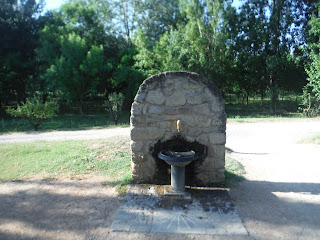


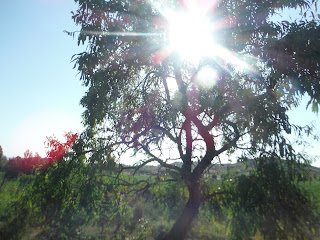

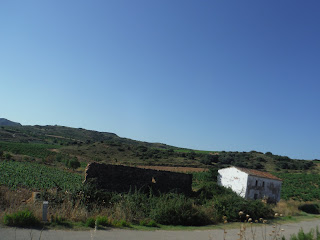



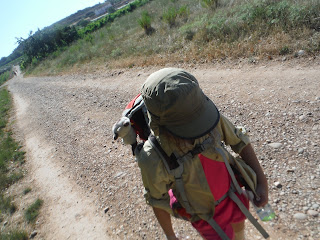





















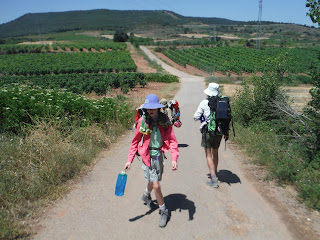

















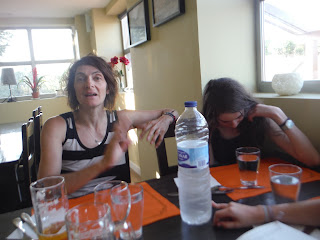































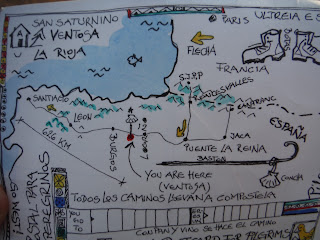






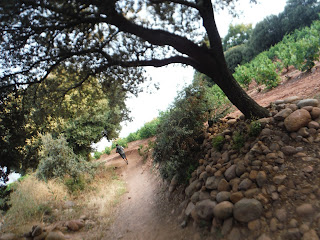







































































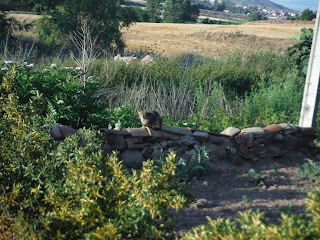












No comments:
Post a Comment